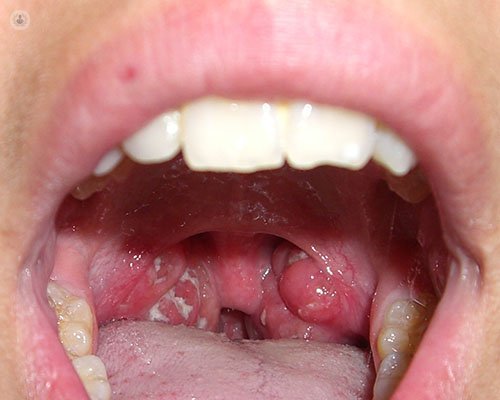Tonsillitis: what types there are and how to deal
Written by:Tonsillitis is the inflammation of the tonsils or tonsils, which are a defense bodies found on both sides of the throat. This inflammation is usually infectious, viral or bacterial cause, and is acquired by direct contact (saliva and contaminated objects) or through the air (coughing and sneezing).
 The most common cause of tonsillitis are viruses, of which there are hundreds of them: adenovirus, influenza viruses and parainfluenza, Epstein-Barr virus (infectious mononucleosis), enterovirus or herpesvirus, among others. As for the most common bacteria is streptococcus pyogenes, but there are a large number of bacteria that can cause, sometimes it is a combination of various germs.
The most common cause of tonsillitis are viruses, of which there are hundreds of them: adenovirus, influenza viruses and parainfluenza, Epstein-Barr virus (infectious mononucleosis), enterovirus or herpesvirus, among others. As for the most common bacteria is streptococcus pyogenes, but there are a large number of bacteria that can cause, sometimes it is a combination of various germs.
Types of tonsillitis
There are different types of tonsillitis. The most common is the infectious acute tonsillitis, which can be viral or bacterial. When this infection occurs repeatedly, it is called recurrent tonsillitis.
There are also cases where the inflammation is chronic, leading to a considerable and permanent increase in the size of the tonsils known as tonsillar hypertrophy, or the accumulation of a white material in the tonsils, which called vernix tonsillitis.
Tonsillitis: Symptoms
In acute tonsillitis incubation period from when a person is infected until symptoms showing it is difficult to establish given the wide variety of microorganisms that can cause it , can go a few hours to one week. This infection causes sore throat when swallowing, fever, appearance of cervical nodes and malaise; sometimes there is also a headache or tummy. Tonsils have a very red appearance, sometimes the presence of pus plates or a kind of whitish membrane on its surface.
Chronic tonsillitis gives a persistent discomfort in the throat, sometimes with loss of appetite and fatigue, and can have permanently swollen glands , or even cause an infection in other body organs. If the tonsils are large they can create respiratory and obstructive sleep problems and disorders in the development of the palate and teeth placement. In Cheesy tonsillitis usually have pain episodes and halitosis.
Treatment for tonsillitis
It is advisable to see a specialist in otolaryngology to confirm the diagnosis and establish appropriate treatment. There are some rapid tests for detecting the presence of streptococcus which would require antibiotic treatment administered, but only bacterial infections should take a specific antibiotic. In this case, it is also important to complete the days prescribed treatment to prevent relapse, although 3-4 days the symptoms often improve.
Antitérmicos-analgesics are also prescribed to relieve pain and fever, which is symptomatic treatment given in viral tonsillitis.
It is recommended to take soft foods at room temperature. There are different types of gargles that can improve the symptoms of angina (salt, honey, thyme, ...). Diluted antiseptic mouthwashes help prevent the colonization of germs in the throat. Acidic juices or hard foods should be avoided as they can inflame the throat even more.
The person suffering from acute tonsillitis should rest at home, at least for the duration of fever for treatment and reduce the spread of the disease. Equally important is frequent hand washing the patient and people who care.
In recurrent infections or obstructive problems surgery may be necessary. Complete removal of the tonsils is called tonsillectomy while reducing called tonsillectomy or amigdaloplastia and can be performed by various techniques (laser, radiofrequency, electrocautery, ...).
Although not common, acute tonsillitis may be complicated by the formation of boils or abscesses around the angina or glands in the neck, and rheumatic fever with cardiac, renal or joint. In chronic tonsillitis syndrome obstructive sleep apnea can occur and tooth malposition and swallowing problems.
Danger signs in these infections are high fever, difficulty swallowing or breathing, or the appearance of red rash on the skin.
Edited by Noelia García Pino



